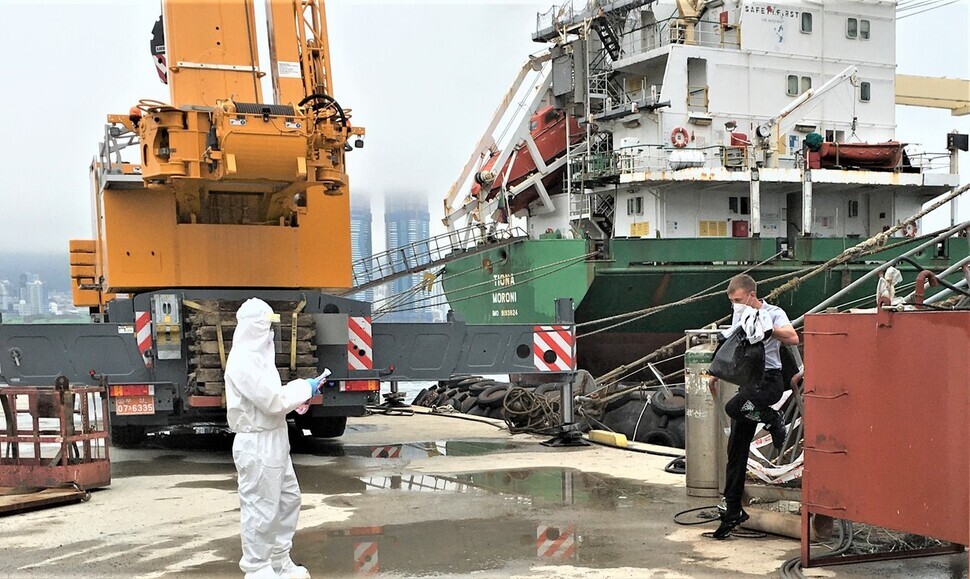hankyoreh
Links to other country sites 다른 나라 사이트 링크
Seoul, Busan see COVID-19 cases of unknown transmission over the weekend

Epidemiological investigations are under way after cases of COVID-19 infection without an identifiable transmission route emerged in Seoul and Busan over the last weekend. While the rate of new community cases diagnosed in South Korea has remained stable in the single digits for the past two days, some are voicing concerns that another outbreak could erupt during the holiday season.
The Korea Centers for Disease Control and Prevention (KCDC) announced on Aug. 2 that a total of nine patients had been diagnosed between July 27 and noon that day in connection with a Hollys Coffee branch near Seolleung Station in Seoul’s Gangnam District and a trotter pork wrap restaurant in the Yangjae neighborhood of Seoul’s Seocho District. No transmission route has been established for the first case.
“Transmission is believed to have taken place when a patient who visited the Hollys Coffee shop subsequently visited the Yangjae trotter pork wrap restaurant in Seocho,” the KCDC said, adding that it was conducting an in-depth epidemiological investigation.
In Busan, a patient in their 40s had been diagnosed the day before, with no known history of contact with any previously diagnosed patients.
“The transmission route has not been established, and the case has been classified as ‘other,’” the city of Busan said. In connection with this, some observers are raising the possibility that the virus may have been transmitted to the local community by ship repair workers who had contracted it from Russian vessels docked at the Port of Busan. Another two crew members were diagnosed from the Petr 1, a Russian deep-sea fishing boat that arrived on July 8, bringing the cumulative total of associated patients to 46.
Sixty-eight out of 102 individuals tested negative after being in contact with nine patients diagnosed in connection with a campground in Hongcheon, Gangwon Province. The remaining 34 are still being tested. The possibility of additional cases remains, with some of the campers failing to adhere properly to disease prevention guidelines. Some campers went grocery shopping without a mask and six families gathered to eat together during their stay on the campgrounds.
Over all, the trend in cases has been one of decline. As of midnight on Aug. 2, the total diagnoses stood at eight community cases and 22 imported overseas cases. A risk assessment for the preceding two weeks (Jul. 19 to Aug. 1) conducted by the Central Disaster and Safety Countermeasures Headquarters (CDSCHQ) showed the average daily number of community cases at 16.9, down by 4.5 from 21.4 two weeks earlier. CDSCHQ First Deputy Director Park Neung-hoo predicted, “Our success with disease prevention during this holiday season will be a crucial watershed for management of the COVID-19 virus during the second half of the year.”
The KDCD has also instructed local governments to develop customized disease prevention measures. South Chungcheong Province, where 33 beaches have been opened, is having visitors wear wristbands after undergoing temperature checks. A day earlier, Daecheon Beach in South Chungcheong began operating a “temperature check tollgate,” which uses an automated device to check the temperatures of vehicle passengers to prevent the risk of virus exposure to disease control personnel.
By Choi Sang-won, South Gyeongsang correspondent, and Choi Ha-yan, staff reporter
Please direct comments or questions to [english@hani.co.kr]

Editorial・opinion
![[Guest essay] Preventing Korean Peninsula from becoming front line of new cold war [Guest essay] Preventing Korean Peninsula from becoming front line of new cold war](https://flexible.img.hani.co.kr/flexible/normal/500/300/imgdb/original/2024/0507/7217150679227807.jpg) [Guest essay] Preventing Korean Peninsula from becoming front line of new cold war
[Guest essay] Preventing Korean Peninsula from becoming front line of new cold war![[Column] The state is back — but is it in business? [Column] The state is back — but is it in business?](https://flexible.img.hani.co.kr/flexible/normal/500/300/imgdb/original/2024/0506/8217149564092725.jpg) [Column] The state is back — but is it in business?
[Column] The state is back — but is it in business?- [Column] Life on our Trisolaris
- [Editorial] Penalties for airing allegations against Korea’s first lady endanger free press
- [Editorial] Yoon must halt procurement of SM-3 interceptor missiles
- [Guest essay] Maybe Korea’s rapid population decline is an opportunity, not a crisis
- [Column] Can Yoon steer diplomacy with Russia, China back on track?
- [Column] Season 2 of special prosecutor probe may be coming to Korea soon
- [Column] Park Geun-hye déjà vu in Yoon Suk-yeol
- [Editorial] New weight of N. Korea’s nuclear threats makes dialogue all the more urgent
Most viewed articles
- 1Behind-the-times gender change regulations leave trans Koreans in the lurch
- 2Yoon’s revival of civil affairs senior secretary criticized as shield against judicial scrutiny
- 3Family that exposed military cover-up of loved one’s death reflect on Marine’s death
- 4South Korean ambassador attends Putin’s inauguration as US and others boycott
- 5Marines who survived flood that killed colleague urge president to OK special counsel probe
- 6A breath of fresh air: Innovative architecture in the time of COVID-19
- 7‘Weddingflation’ breaks the bank for Korean couples-to-be
- 8Dermatology, plastic surgery drove record medical tourism to Korea in 2023
- 9Hybe-Ador dispute shines light on pervasive issues behind K-pop’s tidy facade
- 10[Column] The state is back — but is it in business?